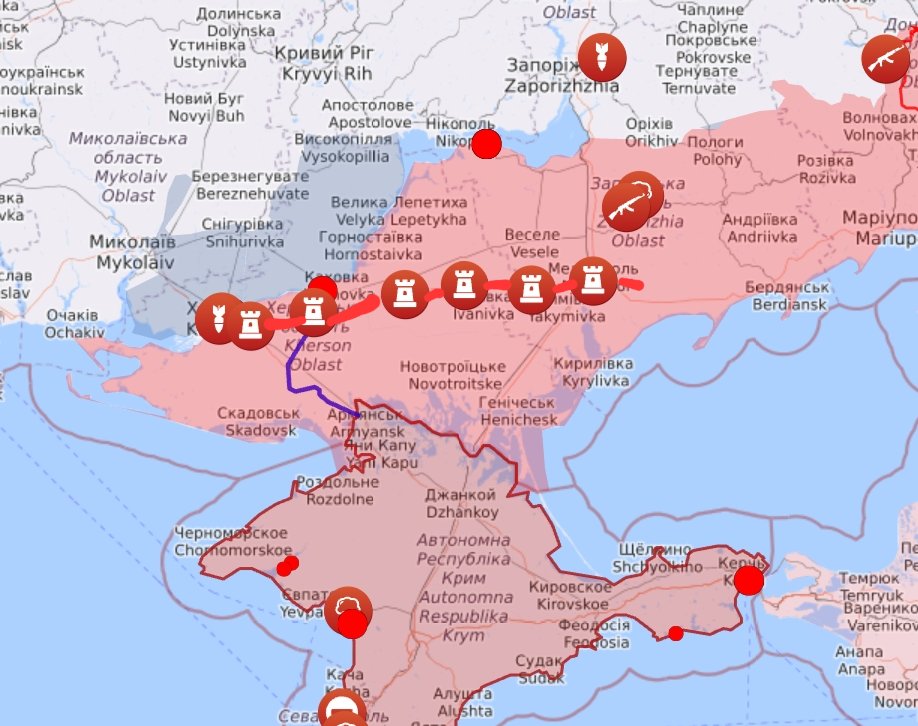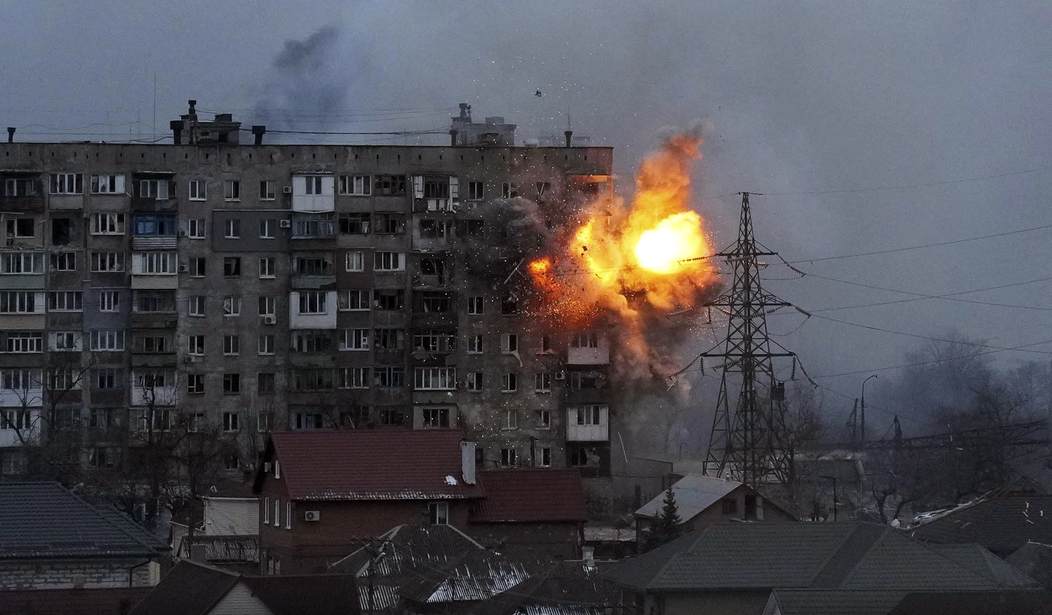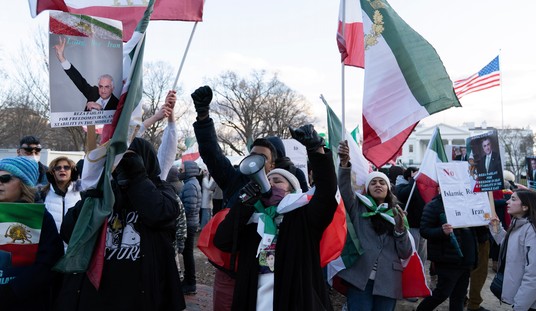(The opinions expressed by contributors are their own and do not necessarily represent the views of RedState.com.)
If on February 24, 2022, someone had told me I’d still be writing about Putin’s War in Ukraine 275 days later, I’d have laughed in their face. And yet, here I am.
The changes in the front lines have been minuscule, but there are areas where the fighting is heating up.
Politico-Strategic Level
Train Service Returns Between Kiev and Kherson
In the physical prosecution of the war, this is probably not a big deal. But, as Napoleon noted, in war, “the moral is to the physical as three is to one.” Reestablishing a rail link from Kiev to Kherson, the only oblast capital city captured by the Russians, gave a major morale boost to the Ukrainians. The symbolism of the reunification couldn’t be missed.
Ukraine's train service has truly been an incredible story throughout this entire war. The people working there have earned this rewarding moment. https://t.co/hKgFhVvfCq
— Neil Hauer (@NeilPHauer) November 19, 2022
🚂First “Victory train” arrived in Kherson today! Impossible to look at these photos without tears ❤️🩹It is the first train from Kyiv since full-scale invasion.
📸Rubryka pic.twitter.com/WVgwyYAFoj
— Margo Gontar 🇺🇦 (@MargoGontar) November 19, 2022
Instead of a thousand words.
As the first train arrives to Kherson, people are able to hug each other for the first time in 9 months.
📷: telegraph pic.twitter.com/YFVuNesFkp
— Anton Gerashchenko (@Gerashchenko_en) November 19, 2022
Germany
Germany has been one of the most reluctant European countries regarding support for Ukraine. Their aid has been “defensive” in nature and slow in coming. When Portugal wished to transfer some obsolescent Leopard 1 tanks to Ukraine (I mean “obsolescent” compared to Western main battle tanks because even obsolescent Western tanks have technical parity with the best Russian tanks), Germany balked.
Part of the reluctance was undoubtedly linked to the cash cow that was the Nordstream gas pipelines. However, part seems to be that the Germans were stump-broke by the Russians in World War II, and something about that experience has prevented the German psyche from seeing the Russian Army as the pathetic, Third World trash that it is.
Boris Johnson created some waves last week when, in an interview, he said that the Germans initially favored a Russian victory in Ukraine. The anticipation of that interview seems to have prodded Putin’s most prominent protector, German Chancellor Olaf Scholz, into action.
Olaf Scholz urged Putin to withdraw troops from Ukraine so negotiations could begin, adding that no one has the right to appropriate someone else's territory, and no country can be considered the backyard of another. pic.twitter.com/EYf7cuKABP
— NOËL 🇪🇺 🇺🇦 (@NOELreports) November 19, 2022
The German-Russian Forum “Petersburger Dialog”, which once have been introduced by Gerhard Schröder and Putin, will be dissolved.
Good riddance.https://t.co/8bGbSHX10x
— (((Tendar))) (@Tendar) November 19, 2022
What is significant about these actions is that they are laying down markers. Scholz is setting the withdrawal of Russian forces to status quo ante February 24 as the precondition for negotiations. This is effectively demanding that Putin acknowledge defeat. The subtext is that Ukrainian “neutrality” is off the table. Scrapping a long-running “dialog” between Germany and Russia is a sign, like the nationalization of Gazprom’s German subsidiary (see Putin’s War, Week 38. The Lines Clarify and Everyone Is Getting Ready for the Next Phase), that the Russo-German relationship has been permanently changed.
Fake Nukes
This war has been full of head-scratchers. Russia has been engaged in cyclical blitzes of Ukrainian heat, water, and electrical utilities for a couple of months. A week ago, an older, nuclear-capable Russian cruise missile, the Kh-55 carrying a simulated nuclear warhead, crashed at Dnipro.
Another source with more details on the recently fired #X55 cruise missile with dummy nuclear warhead#crazy@RoINTEL @TpyxaNews @Aviation_Intel @TheIntelFrog https://t.co/BjloQTS8oU https://t.co/rkGHtnsZIi pic.twitter.com/5O53uYFemM
— Marcus Smith (@internetguy01) November 18, 2022
The idea that the Russians would fire a dud “decoy” missile seems dumb. The Russians are trying to overwhelm Ukrainian air defenses, so sending a decoy makes no sense if the missile could carry a conventional warhead. It also makes no sense unless there is something in the radar signature that would draw the attention of multiple surface-to-air missiles. The dummy nuke doesn’t appear to have any threat attached to it, as the Russians haven’t mentioned it, and Dnipro is not a city that would rate a nuclear strike. Guesses?
Belarus
Belarus seems to have become a weekly topic. Belarus strongman Aleksandr Lukashenko plays a Renfield to Putin’s Dracula. He’s a relentless toadie who hopes his attachment to his master will give him immortal glory (SPOILER ALERT. Renfield ends up with a broken neck). At various times, Lukashenko has seemed on the cusp of wading into the war only to pull back. Belarus is training “mobilized” Russians and permits airstrikes against Ukraine to be launched from Russian-occupied airbases in Belarus. In my last update, I covered Ukraine demolishing bridges, building fences, and laying minefields on their border with Belarus. Finally, that message seems to have sunk in.
Belarusian Defence Minister Viktor Khrenin said that the republic has no plans to intervene in any conflicts.
Good. Because hopefully they know, the minute they cross the border to invade #Ukraine, they will be defeated by 🇺🇦 Armed Forces.
— Maria Drutska 🇺🇦 (@maria_drutska) November 19, 2022
If Belarus intervenes in the war in an active way, I fully expect the Poles to react militarily. Belarus, under Lukashenko, is a bad actor with no allies except Russia. Now that no one is afraid of Russia, Lukashenko is riding a tiger of a restive population and a puppeteer who has less use for him by the day.
North Korea
The North Korean government has been trafficking its citizens as slave labor for decades (interactive map). Russia is the second largest user of North Korean labor after Communist China. Given the totality of the situation, it is hard to see what function this accomplishes other than as a way of the Kremlin currying more favor with Pyongyang. Russia is using North Korean ammunition and winter uniforms in Ukraine, and renting North Korean labor strikes me as a way of keeping Li’l Kim and his henchmen happy.
According to this @The_Daily_NK report, North Korea is recruiting more workers to send to Russian-occupied eastern Ukraine but the first round of workers is still yet to leave. Workers are getting two-year passports but they could be extended. https://t.co/HhzetvFAks
— Martyn Williams (@martyn_williams) November 22, 2022
EU Parliament Labels Russia a “State Sponsor of Terrorism”
As a practical matter, this has little significance. The EU Parliament doesn’t have a process for sanctioning “state sponsors of terrorism.” Instead, it relies on action by the European Commission in Brussels to do the heavy lifting, which the European Commission rarely does. Nevertheless, the fact that the EU Parliament took this step is significant as it is another signal that the EU is decoupling from Russia in a way that will be very difficult to repair.
Following the atrocities carried out by Vladimir Putin’s regime against Ukrainian civilians, MEPs have recognised Russia as a state sponsor of terrorism. Press release: https://t.co/YuBxBaU4GX pic.twitter.com/tf4qxSJLoB
— European Parliament (@Europarl_EN) November 23, 2022
FSB Mistakes Airsoft Group for Ukrainian Partisans
Read the whole thread.
2/ The Russian media reported on 23 November that the FSB had killed three people in Voronezh who it claimed were members of a "conspiratorial cell of supporters of Ukrainian nationalist ideology." They died during an attempt to "extract the means of terror" from a location.
— [email protected] (@ChrisO_wiki) November 25, 2022
Remember when the FSB showed Sim cards when they claimed they had arrested a bunch of Nazis?
This bizarre story about Russia seemingly mistaking SIM cards for the PC game The Sims 3 has been causing a lot of amusement. I don’t think it’s down to stupidity, though – here’s a suggestion for how this may have happened. /1 https://t.co/yLtRE6BFqr
— [email protected] (@ChrisO_wiki) April 26, 2022
Only the best men.
Coming Soon to a Russian Simp’s Twitter Feed
This convoy of military vehicles sporting the Ukrainian flag was seen in Tver, about 110 miles northeast of Moscow. I’m sure we’ll see them in a future video offering on a Russian Telegram channel.
Passers-by in Tver, Russia noticed what looks like setting up to film some fake propaganda garbage.
Remember this vehicle later when you see Adolf Hitler pop out of it wearing a vishivanka. pic.twitter.com/rq0McdzUV9
— Jay in Kyiv (@JayinKyiv) November 26, 2022
Kremlin Imposes Official Censorship of War Coverage
If you need more signs that things are not going well with Putin’s War, this is one to consider.
In #Russia, the FSB security service approved the "list of military information that can be used against Russia".
This new measure will effectively ban political and security analysis and forecasting in Russia from 1 December 2022
1/2https://t.co/Mo8r9jtvdy pic.twitter.com/2sRpfwPV7r
— Alex Kokcharov (@AlexKokcharov) November 22, 2022
Considering that nearly half of Russians 24 and under and over a third of those aged 25-39 use a VPN to evade Moscow’s controls on what they can view on the internet, I’m not sure how successful this policy will be.
Russia and Iran Agree on Drone Production Deal
This is hardly a shock. As I reported in the last update, the Iranian drones have components from several countries, including the US and Israel. I’m not sure how Russia will manage this project.
According to U.S Intelligence Officials the Iranian and Russian Governments have finalized a plan to begin the Mass Production of Iranian Developed Drones inside of the Russian Federation, it’s expected that these Drones will be used for the War in Ukraine and future conflicts. pic.twitter.com/ybxAwIOdAV
— OSINTdefender (@sentdefender) November 19, 2022
Ukrainian Special Forces Kill Iranian Military Advisors
It is a poorly kept secret that Iran has sent drone operators along with its drones. They are operating from inside Crimea. In early October, reports were that a Ukrainian drone attack had killed some of the operators. The Ukrainian Defense Minister, Oleksiy Danilov, has reported that Ukrainian SOF killed Iranian military advisors in Crimea. The article is not specific, but I suspect they are technicians supporting drone operations.
fwiw: Kyiv's targeting of Iranian armed drone operators and personnel in occupied Ukraine has strong echoes of Israel's successful destruction of lethal Iran drone support for Assad in Syria, a few years back. https://t.co/vSwGfDYnrZ
— Chris Woods (@chrisjwoods) November 24, 2022
War of the Generators
I touched on this in past updates. The Russian operational position sucks from basically any angle you wish to consider. In response, the Russians have initiated an operation to deprive Ukraine of electricity, heat, and running water. The concept seems to be that the Ukrainian population if made sufficiently miserable, can force the Zelensky government to the negotiating table from a position of weakness.
Russia has targeted Ukraine’s battered power infrastructure with another barrage of strikes, forcing the country’s last three fully functioning nuclear power plants to disconnect from the grid, the Energy Ministry said. Most consumers have no power. https://t.co/btM8lWlOC3
— The Associated Press (@AP) November 23, 2022
You can see the impact this is having.
Ukraine at night. On February 6, 2022 – without russian missiles. On November 23, 2022 – with russian missiles. pic.twitter.com/8e67P5FNZE
— Daria Kaleniuk (@dkaleniuk) November 24, 2022
The EU is trying to fill the gap with portable generators, but portable generators can’t power cities. Ukraine’s allies are providing replacement generation, transmission, and distribution equipment. The challenge is to repair damage and protect the repaired infrastructure from the next wave of missiles.
The head of the European Parliament, Roberta Metsola, announced the launch of a campaign for the mass supply of electric generators from the EU to Ukraine. pic.twitter.com/kdOIASwesd
— NOËL 🇪🇺 🇺🇦 (@NOELreports) November 23, 2022
Kyiv Mayor Klitschko says power was restored in most parts of the Ukrainian capital within hours of the three nuclear power plants being reconnected to the electricity grid https://t.co/qH1vNQn6Fs
— Euromaidan Press (@EuromaidanPress) November 24, 2022
Very few systems work in a vacuum, and electricity is no exception. Ukraine supplied the electrical power of many of its neighbors. Moldova, in particular, is largely dependent upon Ukrainian power. So the Russian attack on Ukrainian infrastructure is being felt there.
Mass power outages now in Moldova after the missile attack on Ukraine, the Deputy Prime Minister of Moldova said. pic.twitter.com/cipWczGbid
— NOËL 🇪🇺 🇺🇦 (@NOELreports) November 23, 2022
Moldova's president lashes out at Russia for the cruise missile attacks that knocked out her country's electricity networks https://t.co/rMVxnhAo8Q via @yarotrof #Ukraine pic.twitter.com/hmYtuvL2Fo
— Liveuamap (@Liveuamap) November 23, 2022
Pipelines carrying Russian gas also pass through Ukraine and are powered by Ukrainian electricity.
Section of Druzhba oil pipeline in 🇺🇦 was partially stopped because there is no electricity.
If strikes continue, oil supplies to EU will stop completely.
However, from 5 December EU plans an embargo on oil purchases from Russia. pic.twitter.com/xjjJn5lFGK
— Anton Gerashchenko (@Gerashchenko_en) November 23, 2022
The flow of Western air defense systems attrits about 80 percent of every Russian missile attack. That’s great, but 20 percent still get through. More air defense systems are on the way, and as the Ukrainian become more familiar with Russian attacks, their defenses will become more effective. European equipment can keep the Ukrainian grid somewhat functional.
Ultimately, this is a contest between the number of missiles Russia is willing to shoot — and that number is not infinite — and the will of the Ukrainian people.
Historically, targeting civilian populations has had the opposite effect of cowing them into submission. I don’t see any reason why this will turn out differently.
Operational Level
Like last week, I’m dropping most maps because nothing has changed. A lot of Russian Telegram sites portray gains of a few dozen meters as though they are breakthroughs. What they fail to report is that nearly all gains by both sides are relinquished after a few hours or days.
New Weapons
British Brimstone Upgrade
Britain transferred the first ground-based Brimstone missiles to Ukraine in May. They are similar to the US Hellfire and can be fired in a volley against a target array, with each missile seeking its own target.
Great Britain has supplied Ukraine with modernized high-precision Brimstone 2 missiles, the launch range of which is three times greater than the previously transferred first-generation Brimstone missiles – The Daily Telegraph. pic.twitter.com/dUlkvNicbp
— M|§F|T 🇺🇸🇺🇦 (@am_misfit) November 22, 2022
Turkish TRLG-230 Multiple Launch Rocket System
The Turks have supplied some number of TRLG-230 MLRS to Ukraine. The TRLG-230 is similar in some respects to the US M270 MLRS and HIMARS.
🇹🇷The first recorded use of the Turkish TRLG-230 MLRS in Ukraine https://t.co/ohz5eNEukv pic.twitter.com/s8GiPbHs8p
— ТРУХА⚡️English (@TpyxaNews) November 22, 2022
SH-3 Sea King Helicopter
Britain is retiring its fleet of SH-3 Sea King anti-submarine helicopters. Some of them are headed to Ukraine. I suspect they will all end there either as operational aircraft or spares. The Sea King is primarily used in the anti-submarine mission but can carry 26 troops or 15 stretchers. This is just another instance of more capable Western equipment replacing the Russian equipment Ukraine had relied upon.
the UK just gave ukr 3 sea king helos… and 10 crews are training on them… with about 30-40 aircraft in the EU being retired right now this could be a great transport helo for the ukr military… https://t.co/uPPE64dZPN
— david D. (@secretsqrl123) November 24, 2022
Another Naval Drone Attack
A month ago, the Ukrainians attacked Russia’s Black Sea Fleet in port using naval drones; Ukraine Carries out Extensive Drone Attack on Russia’s Black Sea Fleet Sevastopol Homeport. A second such attack has now been carried out against ships at the Transneft oil terminal in Novorossiysk, Russia. As a result, tankers have stopped entering the port.
Ukraine is writing a new chapter in the history of naval warfare.
The second ever attack with USV maritime drones took place today.
The drones attacked the Sheskharis oil harbor in Novorossiysk, Russia, owned by Transneft.
Keep striking Russian ports, it will cripple logistics pic.twitter.com/d1gFaZs12r
— Visegrád 24 (@visegrad24) November 18, 2022
Novorossiysk is far away from the nearest Ukrainian-controlled territory and the Russians believed it was out of reach.
Turns out that wasn’t the case. pic.twitter.com/xsRmUQRrDz
— Visegrád 24 (@visegrad24) November 18, 2022
Occupied Sevastapol has been under attack by what appears to be an extended Ukrainian drone strike for almost an hour now.
Additional explosion were reported a few minutes ago . pic.twitter.com/EtXQidl9al
— Artoir (@ItsArtoir) November 22, 2022
Prisoner Exchange
The numbers are smaller than those I covered in the last update, but they continue.
Another prisoner exchange took place today
50 🇺🇦 soldiers returned from Russian captivity.
Among them are two officers and 48 privates and sergeants.19 defenders of Mariupol, 12 of whom were from Azovstal, as well as 15 prisoners from Chernobyl NPP and 7 from Zmeiny Island. pic.twitter.com/HBbicJIanR
— Special Kherson Cat 🐈🇺🇦 (@bayraktar_1love) November 24, 2022
🇷🇺🇺🇦 A new prisoner exchange between #Russia and #Ukraine has been announced.#Russia has reported the return of 35 of its fighters. #Ukrainian forces announce that 36 of their men are returning home with 20 #Mariupol defenders already among those released. pic.twitter.com/tYd6WKYeot
— Russo Ukranian War Updates (@CaliJournalism) November 24, 2022
Today the AFU released 12 soldiers/locals from Russian captivity after an exchange. Among them – 4 soldiers of the Navy, 2 national guardsmen, 2 border guards, 1 from TDF, as well as three civilians – a spouse and a husband who was considered missing. pic.twitter.com/OTdaTt2GXL
— NOËL 🇪🇺 🇺🇦 (@NOELreports) November 26, 2022
Combat Operations
Kherson/Zaporizhzhia Area of Operations
I’m compressing the combat operations part of the update this week. While a lot of slugging is going on in Kherson and Donbas, I’m not convinced that it is leading to anything. As I said last week, the center of gravity of the entire war has swung to Kherson/Zaporizhzhia. A successful Ukrainian offensive towards Melitopol will force the evacuation of the remainder of occupied Kherson because it can’t be supplied. From last week:
I’ve written before about the danger posed by a Ukrainian offensive on the Tomak-Melitopol axis in Zaporizhzhia. It looks like the Russians see what a lot of other folks and I see.
The General Staff notes the increase in the group of 🇷🇺 troops in the Melitopol region.
"Fortifications are being built around the perimeter of the city. Civilians are prohibited from approaching the airfield area. Columns are arriving to the city from the side of Tokmak" pic.twitter.com/qlB4CJqujU
— International Observers Ukraine (@INTobservers) November 13, 2022
Last update, the Russians were preparing positions around Melitopol. This week, via commercial satellite imagery, we see a series of defensive lines being developed along the E58 highway from Melitopol to Nova Kakhovka.

I don’t have the imagery, so I can’t make inferences, but it looks like the line is situated to prevent any Ukrainian breakthrough towards Melitopol from threatening Crimea. Does this imply that Russia is preparing to sacrifice the area north of the defensive line and conduct a planned retrograde operation from the existing front line? Because the Russians don’t have enough troops to man the current front and simultaneously defend the line, they are building. If they don’t, then should a breakthrough take place, the odds of being able to stop a retreat fast enough to man the defensive line are pretty slim.
As the defense line is being built, Russian military equipment is moving north from Mariupol to the front.
GeoLocation:https://t.co/vklxJcM205
— GeoConfirmed (@GeoConfirmed) November 22, 2022
BREAKING: Russia began to transfer manpower through Mariupol in the direction of Gulyaipol
At least two convoys of trucks and engineering equipment, went through the city through the village. Nikolske in the direction of Gulyaipol, – said the adviser to the mayor of Mariupol. pic.twitter.com/CFTkEBG1uR
— Russia Ukraine Conflict (@Russiaconflict) November 21, 2022
What’s Next?
Both sides are paused, waiting for a temperature drop to freeze the gloppy mud of the rasputitsa.
This is what bezdorizhzhya (Ukr)/rasputitsa (Rus) season does to the frontline trenches. Tens of thousands of Ukrainian and Russian troops are experiencing this right now. https://t.co/gJaMr8HMEg
— Christopher Miller (@ChristopherJM) November 26, 2022
Rasputitsa. pic.twitter.com/IsUv9vrPOR
— ДражаМ (@DrazaM33) November 22, 2022
When the ground becomes trafficable, then the operational tempo picks up again. The army best able to fight in the cold and under austere conditions wins. I think this favors the Ukrainians, who are more motivated, disciplined, and equipped. My gut is that the weather will kill or put out of action more Russians than the Ukrainians.
Everything is pointing to a major offensive by the Ukrainians aiming at Mariupol. At this point, I can’t guess the timing. What I’m not afraid to say is that when the offensive kicks off, the Russians will not have the combat power or the tactical flexibility to stop it. The challenge for the Ukrainians, one they haven’t handled as adroitly as the tactical part of the equation, is producing the logistical means for sustaining their tactical successes.












Join the conversation as a VIP Member